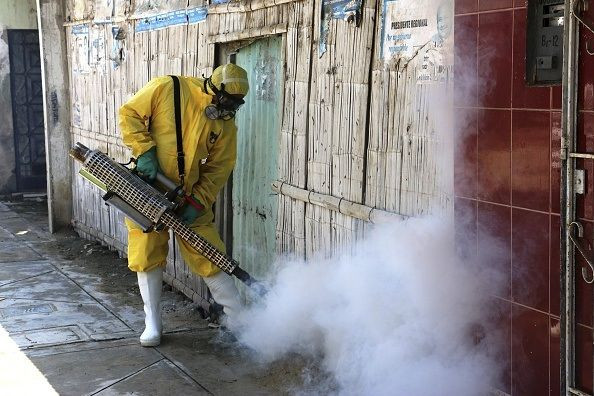Zika And Ebola Are Both Global Health Emergencies, But The Responses Will Look Very Different

No sooner have fears of the Ebola epidemic in West Africa faded from public memory than a new outbreak has risen in its stead: the Zika virus, a mosquito-borne illness that has been associated with an alarming rise in babies with birth defects and neurological problems.
The World Health Organization said Monday the ongoing outbreak of the virus is a public health emergency of international concern, granting it a designation last conferred on the Ebola epidemic, which left more than 11,000 dead and invited blistering criticism of the WHO for failing to respond appropriately. Despite sharing a label, however, the global response to the Zika virus is likely to be very different — and substantially better — than the response to Ebola, experts said.
The world is responding to the Zika virus much sooner than it has done with previous outbreaks, including Ebola, said Amesh Adalja, who is a senior associate at the Center for Health Security at the University of Pittsburgh Medical Center. The regional office of the WHO in the Americas, known as the Pan American Health Organization, has a robust track record of dealing effectively with infectious diseases, Adalja added.
An independent assessment commissioned by the WHO to review the organization’s response to the Ebola epidemic found that it failed to react adequately to the epidemic and lacked “the capacity or organizational culture to deliver a full emergency public health response.” Other assessment panels drew similar conclusions, and experts said the organization is eager not to make the same mistake again.
“They certainly don’t want to be in the same position they found themselves in last time [with Ebola], where the outbreak got ahead of itself before the global threat was fully appreciated,” said Chris Woods, a professor of global health at the Duke Global Health Institute in Durham, North Carolina.
That could be one reason a group of independent experts recommended to WHO Director-General Margaret Chan Monday that Zika constitutes a global threat. Such a designation not only helps to redirect national and local funding to fighting the Zika virus, it also helps attract attention from major international donors.
Certain geographic factors also work in favor of public health when it comes to combating the Zika virus. One is that the World Health Organization is grouped into six regional offices, a bureaucratic structure that is not just symbolic, but also has a genuine and significant impact on the organization’s overall effectiveness.
Via @Reuters, countries impacted by #Zika... And those that may be soon due to prevalence of #Aedes mosquitoes. pic.twitter.com/3mJsDxun8r
— Maia Majumder, MPH (@maiamajumder) January 26, 2016
“In the end, the World Health Organization is only as strong as the regional office in charge,” Devi Sridhar, a professor in global public health at the University of Edinburgh in Scotland, said.
The regional office for the Americas, the Pan American Health Organization, predates the WHO. Founded in 1902 as the Pan American Sanitary Bureau, it was subsumed into the bigger global agency upon the establishment of the WHO in 1948.
Long before joining the newly conceived WHO, however, the Sanitary Bureau already had a robust and laudable record of achievement. Thanks to its work, drastic but common quarantine measures were rendered unnecessary, as diseases like yellow fever, cholera and the bubonic plague were slowly brought under control. Because of the bureau, “a better understanding has been brought about between the health authorities of the republics of America,” wrote Bolivar J. Lloyd, then the medical director of the U.S. Public Health Service, in 1930.
“PAHO is usually considered the highest level of expertise with the World Health Organization,” Adalja, of the University of Pittsburgh Medical Center, said of the regional office. “Most public health authorities have a lot more confidence in PAHO, versus the African office of the World Health Organization.”
Countries in South America also tend to be more industrialized and politically stable, with more resources and better infrastructure, than the impoverished, post-conflict nations of Liberia, Sierra Leone and Guinea that bore the brunt of the Ebola outbreak, several experts pointed out.
“All of the Ebola response review reports note that basic public health infrastructure is the first step to pandemic preparedness,” Sridhar, the Edinburgh professor, said. “And Brazil’s health system is so much more advanced than Guinea’s.”
As of Monday, 25 countries, most of them in the Americas, had reported cases of the virus, which people acquire through the bite of Aedes mosquitoes. That’s hardly like the Ebola virus, which is highly infectious and typically kills half of those it infects. It spreads from one human to another through direct contact with contaminated bodily fluids, and victims require significant, intensive medical care.
The current Zika virus outbreak has its origins in Brazil, where the first case of local transmission was reported last May. Then, in the fall, the country saw a spike in the number of babies born with microcephaly, a birth defect that can cause developmental delays and a host of other disabilities. Researchers also suspect but have not proved a link between the virus and Guillain-Barré syndrome, which causes temporary paralysis.
Given these characteristics, the Zika virus poses a unique kind of threat to public health, said Woods. “The person who is actually ill is not at risk,” he said. Instead, he added, “it’s the downstream risk to the unborn child” that makes Zika so terrifying.
© Copyright IBTimes 2024. All rights reserved.






















